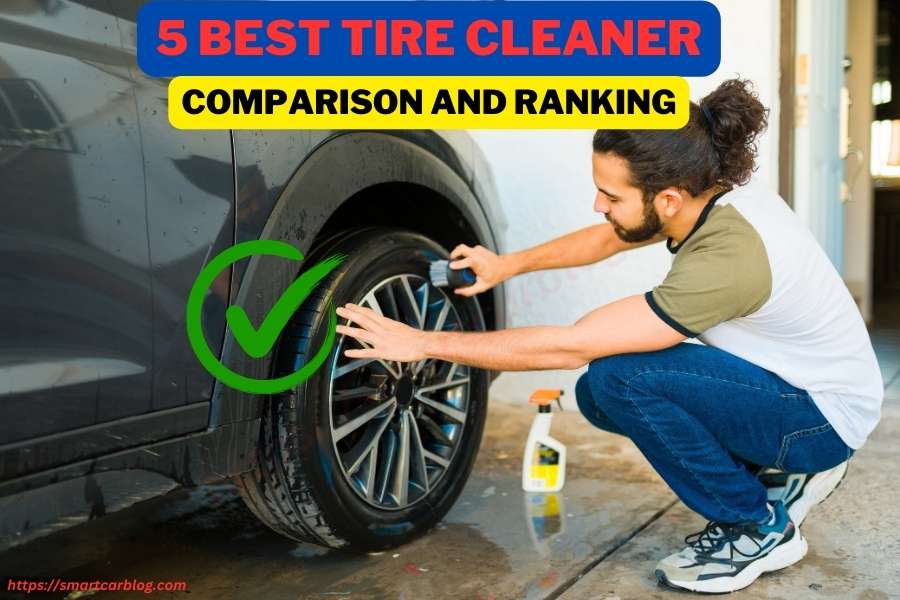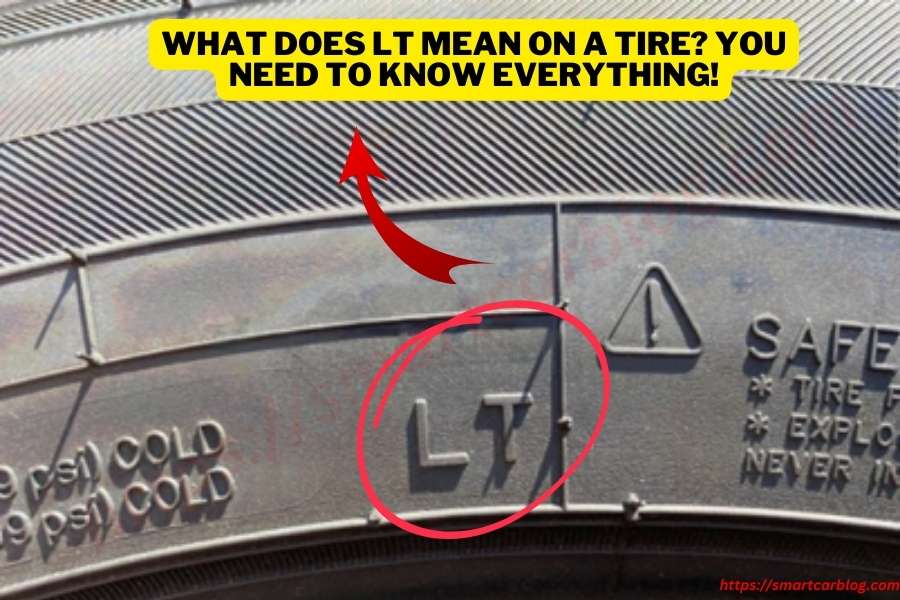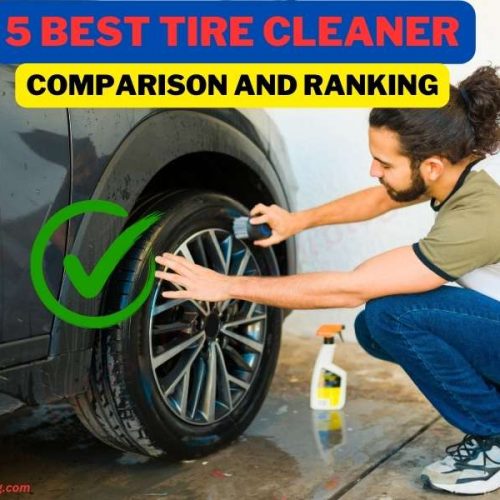Tires are crucial for your vehicle, but decoding their markings, especially the question “What Does LT Mean on a Tire?” It can be bewildering. If you’ve ever wondered about its meaning and importance, you’re not alone. Imagine standing before your vehicle, fixating on those two letters, “LT,” seeking answers but only finding vague explanations. It’s akin to solving a riddle without a key, leaving you uncertain about your vehicle’s safety.
No need to fret—we’re here to bring clarity. In this guide, we’ll demystify the “LT” on your tires, explaining its meaning, significance, and why it matters for your vehicle. By the end, you’ll not only know what “LT” stands for but also understand its impact on your driving experience. Ready to uncover the mystery of “LT” on your tires? Keep reading, and by the end of this article, you’ll know how to make informed decisions for a smoother, safer ride.
Table of Contents
ToggleUnderstanding Tire Markings
When you look at a tire, you’ll see a series of letters and numbers that might seem like a confusing jumble at first. But fear not; these markings are more cryptic than they appear. They’re actually quite informative once you decode them. These markings tell you everything from the tire’s size and load capacity to its type and intended use. Among these markings, one you might often come across is “LT.”
What Are LT Tires?
Have you ever found yourself staring at the sidewall of a tire and wondering what all those letters and numbers mean? It’s like a secret code from the world of automobiles. One such mystery is the abbreviation “LT” that often pops up on certain tires.
LT tires, standing for Light Truck tires, are specially designed for vehicles that mean business. We’re talking about pickup trucks, SUVs, and even vans that are often on heavy-duty missions – towing trailers, carrying hefty loads, or navigating rough terrain. These power players in the tire world, unlike regular passenger tires, are built to endure more stress, tire weight, and rougher conditions.
What Does LT Mean on a Tire?
So, what’s the big deal with LT, you ask? LT, short for Light Truck, isn’t just a label; it’s a promise of toughness. The term “LT” at the beginning of a tire code proudly signifies that engineers have designed the tire specifically for the heightened demands of light trucks. These tires boast a higher load capacity and function under higher inflation pressures, unlike standard passenger tires. This means they can carry heavier loads without breaking a sweat, making them ideal for your haul-it-all pickup or your adventure-ready SUV.
Why Does “LT” Matters for Your Vehicle?
Choosing the right tire for your vehicle is like picking the right shoes for a marathon – you need the perfect fit and endurance. For vehicles that are constantly pulling heavy loads, traversing off-road paths, or just need that extra bit of strength, LT tires are the go-to choice. They provide better stability, durability, and safety for vehicles that work as hard as you do.
Whether you’re towing a boat for a weekend getaway or hauling equipment for your next big project, LT tires ensure that your vehicle is up to the task. They’re built to not only support the weight but also to offer a stable and controlled driving experience. This means less worry about tire blowouts and more focus on the road ahead.
Understanding the ‘LT’ on your tire is crucial for ensuring you’re equipping your vehicle with the right gear. These tires aren’t just about carrying weight; they’re about confidence, safety, and performance. So, the next time you’re tire shopping, remember that ‘LT’ isn’t just a label – it’s a symbol of your vehicle’s capability and your peace of mind.
When To Use LT Tires?
Knowing when to use LT tires can significantly influence your vehicle’s performance and safety. These tires are designed for specific conditions and should be used accordingly. Here’s when you should consider LT tires:
Heavy-Duty Use: If your vehicle is regularly used for hauling heavy loads, be it equipment, materials, or even a large number of passengers, LT tires are ideal. Their enhanced load-carrying capacity makes them suitable for these tasks.
Towing Needs: Vehicles that frequently tow trailers, boats, or caravans benefit greatly from LT tires. The strength and stability of these tires make towing safer and more efficient.
Rough Terrain: For those who venture off-road or drive on challenging terrains, LT tires offer the durability and resilience needed to navigate such conditions without compromising the vehicle’s performance or safety.
Commercial Vehicles: Vans, buses, and trucks used for commercial purposes often require the robustness of LT tires to handle the demands of constant, heavy use.
The Differences Between LT Tires And P-Metric Tires
Regarding P-metric tires, when it comes to selecting tires for your vehicle, it’s crucial to understand the differences between LT (Light Truck) and P-metric tires. These designations have significant implications for the tire’s construction, performance, and intended use.
Defining LT and P-Metric Tires
👉 LT Tires: The “LT” designation signifies Light Truck, but these tires cater to a broader array of vehicles than the name suggests. They are engineered for vehicles demanding high load capacity and durability. Typically employed on trucks, SUVs, and vans tasked with managing hefty loads or towing trailers, LT tires feature reinforced sidewalls and can endure higher air pressure, enabling them to bear greater weight.
👉 P-Metric Tires: The “P” in P-metric tires denotes Passenger. These tires are crafted for standard passenger vehicles like sedans, minivans, and compact SUVs. P-metric tires prioritize comfort and efficiency, delivering a smooth ride under regular driving conditions. They are intended for something other than substantial loads or rugged terrains, in contrast to their LT counterparts.
Load Capacity Comparison
The principal distinction between LT and P-metric tires lies in their load capacity.
👉 LT Tires: These tires are the workhorses of the tire realm, capable of supporting heavier loads owing to their robust structure and ability to handle higher air pressure. This makes them well-suited for vehicles frequently laden with heavy cargo or utilized for towing.
👉 P-Metric Tires: While P-metric tires are designed for everyday driving scenarios, their load capacity is lower compared to LT tires. They are optimized for fuel efficiency, a comfortable ride, and satisfactory performance under standard load conditions.
The variance in load capacity extends beyond personal preference, impacting safety and functionality. Utilizing the appropriate tire type tailored to your vehicle’s specific requirements ensures peak performance and mitigates the risk of tire failure.
What is the Difference Between HT and LT Tires?
When you’re navigating the world of tires, two terms you’ll often encounter are HT and LT. Understanding the disparity between these two can be important for choosing the right tire for your vehicle.
👉 HT Tires – Highway Terrain: HT, or Highway Terrain tires, are primarily designed for drivers who spend most of their time on paved roads. They offer a comfortable ride, low noise, and good fuel efficiency. HT tires are ideal for everyday driving, especially for SUVs and light trucks that rarely venture off the beaten path.
👉 LT Tires – Light Truck: On the other hand, LT, which stands for Light Truck, tires are built for heavier loads and more rugged conditions. These tires have stronger sidewalls and a more aggressive tread pattern, making them suitable for off-road driving, towing, and carrying heavy loads. They’re the go-to choice for vehicles that frequently perform heavy-duty tasks.
Key Differences between LT and HT
- Usage: HT tires are for regular, highway-oriented driving, while LT tires are for more demanding, heavy-duty use.
- Construction: LT tires are built tougher with reinforced sidewalls, whereas HT tires focus on comfort and efficiency.
- Performance: LT tires excel in off-road conditions and load carrying, while HT tires offer a smoother, quieter ride on highways.
Advantages of LT Tires
When it comes to choosing tires for your light truck or heavy-duty vehicle, LT tires come with a bag full of advantages. Here’s why they might just be the best fit for your vehicle:
Superior Load Carrying Capacity: LT tires are the heavy lifters of the tire world. These tires are designed to support heavier loads, and they are perfect for vehicles that carry heavy equipment or tow trailers. It’s like having a trusty workhorse that ensures your vehicle won’t buckle under pressure.
Enhanced Durability: Let’s face it, the road can be tough. But LT tires are tougher. Stronger sidewalls and more robust construction build them, allowing them to handle rough terrains, bumps, and bruises much better than their passenger tire counterparts.
Better Traction and Stability: Whether you’re navigating a muddy back road or hauling a load across town, LT tires provide improved traction and stability, which means a smoother, safer ride, especially under challenging driving conditions.
Longer Lifespan: Thanks to their rugged construction, LT tires often have a longer lifespan. They’re less likely to succumb to wear and tear, meaning you won’t have to replace them as often. In the long run, they can be a more economical choice.
Disadvantages of LT Tires
However, as with anything, LT tires have their flip side too. Here are some disadvantages to consider:
Harder Ride Quality: The very feature that makes LT tires durable can also lead to a stiffer, less comfortable ride. The reinforced sidewalls that provide stability and load support can also make the Ride feel less cushioned.
Reduced Fuel Efficiency: The robust construction of LT tires means they have more rolling resistance. This can lead to a decrease in fuel efficiency, as your vehicle has to work a bit harder to keep those tough tires rolling.
Higher Price Point: Quality comes at a price, and LT tires are generally more expensive than regular passenger tires. This initial investment might be a consideration if you’re on a tight budget.
Not Suitable for All Vehicles: Just because LT tires are great for heavy-duty use doesn’t mean they’re a good fit for every vehicle. Using LT tires on lighter vehicles can lead to overkill, negatively affecting ride quality and fuel efficiency.
Note: Although LT tires provide various advantages, including increased durability, superior load capacity, and enhanced traction, they also entail certain drawbacks. These drawbacks encompass a firmer ride, diminished fuel efficiency, and a higher overall cost. Choosing the right tire depends on your vehicle’s requirements and your usage. If your vehicle’s workload demands strength and endurance, LT tires are the way to go. But for every day, lighter use, you might want to stick to passenger tires.
Maintenance and Care for LT Tires
Taking care of your LT (Light Truck) tires is not just about prolonging their lifespan; it’s about ensuring safety, performance, and reliability. Here’s a guide to help you keep your LT tires in top shape:
Regular Inspections: The first step in tire maintenance is regular inspections. Look out for signs of wear and tear, such as cracks, bulges, or uneven tread wear. These inspections can catch potential problems early, preventing accidents and costly replacements.
Proper Inflation: Keeping your tires properly inflated is crucial. Under-inflated tires can lead to poor handling, increased wear, and even blowouts, while over-inflated tires can make your ride less comfortable and reduce the traction. Check your vehicle’s manual for the recommended tire pressure, and use a reliable gauge to keep your tires at the right level.
Rotation Schedule: Tire rotation is key to extending the life of your tires. Rotating your tires as recommended (usually every 5,000 to 8,000 miles) ensures even wear, which is especially important for vehicles that carry heavy loads or tow trailers.
Balancing and Alignment: Keeping your tires balanced and your vehicle properly aligned is essential. Imbalances can cause vibrations, leading to driver fatigue, premature tire wear, and unnecessary strain on your vehicle’s suspension. Regular alignment checks help ensure your tires meet the road at the correct angle, promoting even wear and optimal handling.
Cleaning: Remember to underestimate the power of keeping your tires clean. Dirt, road salt, and other debris can lead to the deterioration of the rubber. A simple cleaning with soap and water not only keeps your tires looking good but can also extend their life.
Will the LT Tire Last Longer?
When it comes to tire longevity, LT (Light Truck) tires often come out ahead, especially under certain conditions. Here’s why:
✔ Robust Construction: LT tires are built to withstand tough conditions. Designers craft their reinforced sidewalls and durable rubber compounds to withstand the rigors of heavy loads and rough terrains. This sturdy construction often results in a longer lifespan, particularly when you maintain the tires well and use them in the conditions they’re intended for.
✔ Resistant to Wear and Tear: The heavy-duty nature of LT tires means they’re less prone to wear and tear compared to standard passenger tires, particularly when used for their intended purposes, like towing or carrying heavy loads.
✔ Depends on Usage: However, it’s important to note that tire life also depends on usage. If LT tires are used on lighter vehicles or primarily on smooth highways, the advantage in longevity might be less significant.
Why Do LT Tires Have a Deeper Tread?
The deeper tread on LT tires isn’t just for show; it serves several important functions:
Enhanced Traction: The deeper tread provides better grip and traction, which is essential for vehicles that traverse challenging terrains or need extra stability when carrying heavy loads.
Durability in Tough Conditions: The deeper tread allows LT tires to withstand tough, uneven surfaces, like off-road trails or construction sites, without quickly wearing down.
Safety in Extreme Weather: Moreover, this particular tread design plays a vital role in safety, particularly in severe weather conditions. It enhances water evacuation, thereby reducing the likelihood of hydroplaning and contributing to overall safety.
In Which Case Should I Use an LT Tire?
Choosing an LT tire depends on your vehicle’s usage:
Heavy-Duty Work: If you frequently use your vehicle for towing heavy trailers, transporting heavy loads, or if it’s a commercial vehicle like a van or a pickup truck, LT tires are the ideal choice.
Off-Road Adventures: For those who love to explore off-the-beaten paths, the durability and traction of LT tires make them a great fit for off-road conditions.
Larger, Heavier Vehicles: Vehicles like larger SUVs, motorhomes, or trucks that bear more weight can benefit from the load-bearing capacity and stability offered by LT tires.
Final Thought: What Does LT Mean on a Tire?
The term ‘LT’ on tires, standing for Light Truck, is more than just a label; it represents a crucial element in tire technology and vehicle performance. LT tires are designed for resilience, capable of handling heavier loads, tougher terrains, and more challenging conditions than standard passenger tires. They are a symbol of durability, ideal for activities like towing, hauling, and off-road adventures.
Makes them not only essential for optimal tire performance but also for the overall safety and efficiency of heavier vehicles like trucks and SUVs. Understanding what ‘LT’ means on a tire is key to choosing the right tire for your vehicle, ensuring it can support various weights and challenges. LT tires are thus a robust, reliable choice for those seeking stability and safety, especially for vehicles used in demanding conditions. Ultimately, knowing the significance of ‘LT’ helps in making informed decisions that enhance a vehicle’s performance, safety, and suitability for its intended tasks.
FAQ about LT tires
Q: Are LT Tires Better?
A: LT tires are “better” in the context of needing durable, heavy-duty tires for vehicles like trucks, SUVs, or vans that carry heavy loads or go off-road. They offer higher load capacity and are more robust than standard passenger tires. However, for everyday driving conditions, passenger tires might be more suitable due to their comfort and efficiency.
Q: What are LT and HT in Tires?
A: LT in tires stands for Light Truck, indicating tires designed for heavier loads and tougher driving conditions. HT, or Highway Terrain tires, prioritize comfort, efficiency, and smoother performance on highways, as they are designed for regular driving conditions.
Q: What is the Difference Between HT and LT Tires?
A: The key difference lies in their intended use. HT tires cater to smooth, efficient highway driving, offering comfort and noise reduction. At the same time, designers build LT tires for heavier-duty tasks, featuring a stronger build and higher load capacity, suitable for towing and off-roading.
Q: Why are LT Tires So Expensive?
A: LT tires are typically more expensive due to their robust construction, higher-quality materials, and the technology that goes into making them durable and suitable for heavy-duty use.
Q: Are LT Tires Loud?
A: Due to their aggressive tread patterns designed for traction and durability, particularly on rough terrains, LT tires can be louder than passenger tires.
Q: When Should I Buy LT Tires?
A: You should consider buying LT tires if you regularly use your vehicle for towing, hauling heavy loads, or off-road driving. They are ideal for trucks, larger SUVs, and vehicles that require a higher load capacity.
Q: What is PC vs LT Tyre?
A: PC, which stands for Passenger Car, pertains to tires tailored for regular vehicles such as sedans and smaller SUVs. Emphasizing comfort and fuel efficiency, tire designers create these tires for everyday use. On the other hand, engineers design LT, or Light Truck tires, for weightier vehicles and challenging conditions. They provide enhanced durability and a greater load capacity.
Q: Are LT Tires Harder to Balance?
A: Balancing LT tires can sometimes be more challenging due to their heavier and sturdier construction. However, with proper equipment and expertise, they can be balanced effectively.
Q: Do LT Tires Use More Gas?
A: LT tires can lead to a slight increase in fuel consumption due to their heavier weight and higher rolling resistance compared to standard passenger tires.
Q: Do LT Tires Have a Speed Rating?
A: Yes, LT tires do have speed ratings, which are typically lower than passenger car tires due to their focus on load capacity and durability rather than speed.
Q: What is the Most Common LT Tire Size?
A: The most common LT tire size varies based on vehicle type and usage. Sizes like LT265/70R17 are popular for many trucks and SUVs.
Q: How Much PSI is in LT Tires?
A: The PSI (pounds per square inch) in LT tires depends on the vehicle and tire specifications. It’s typically higher than in passenger tires, aligning with their capacity to carry heavier loads.
Q: How Do You Read LT Tire Size?
A: LT tire size is read similarly to other tires: ‘LT’ (type) followed by the width in millimeters, aspect ratio, and the diameter of the wheel in inches. For example, the code LT265/70R17 indicates that it’s an LT tire, 265 mm wide, with an aspect ratio of 70, designed for a 17-inch wheel.
Q: What Does LT 265 70r17 Mean?
A: Specifically, LT 265/70R17 denotes a Light Truck tire, measuring 265 mm in width, with a sidewall height equal to 70% of the width, designed to fit a 17-inch wheel.
Q: How Do I Know if My Tire is LT or P?
A: Check the sidewall of your tire. If it starts with ‘LT,’ it’s a Light Truck tire. If it starts with ‘P,’ it’s a Passenger car tire. This marking indicates the tire type and its intended use.




 Welcome to SmartCarBlog.com! I’m Rashel Miajee, The proud founder of smartcarblog.com. This is a part of
Welcome to SmartCarBlog.com! I’m Rashel Miajee, The proud founder of smartcarblog.com. This is a part of 


